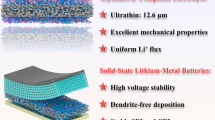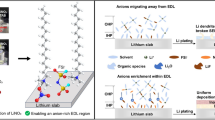Abstract
N-cyanoethyl polyethylenimine (CN-PEI) is synthesized by modifying polyethylenimine (PEI) with acrylonitrile through a Michael addition reaction. Depending on cyanoethylation level, CN-PEI can be obtained as a form of solution, micro-emulsion or emulsion in water. CN-PEI micro-emulsion is investigated as water-soluble binder for the application of lithium iron phosphate (LFP) cathode in lithium-ion batteries. CN-PEI binder not only maintains the outstanding dispersion capability of PEI but also exhibits an excellent adhesion strength and higher ionic conductivity because of the introduction of polar cyano groups. As a result, CN-PEI binder can effectively maintain the mechanical integrity and decrease the polarization of LFP electrode during the operation of the battery. LFP electrode with CN-PEI binder exhibits good cycle stability and enhanced rate performance delivering a capacity of 99.6% at a rate of 0.5 C after 100 cycles and a high discharge capacity of 102.4 mAh g−1 at 5 C.








Similar content being viewed by others
References
Li GR, Ling M, Ye YF, Li ZP, Guo JH, Yao YF, Zhu JF, Lin Z, Zhang SQ (2015) Acacia senegal-inspired bifunctional binder for longevity of lithium–sulfur batteries. Adv Energy Mater 5(21):1500878
Li C-C, Lin Y-S (2012) Interactions between organic additives and active powders in water-based lithium iron phosphate electrode slurries. J Power Sources 220:413–421
Wang QS, Ping P, Zhao XJ, Chu GQ, Sun JH, Chen CH (2012) Thermal runaway caused fire and explosion of lithium ion battery. J Power Sources 208:210–224
Ryou MH, Kim J, Lee I, Kim S, Jeong YK, Hong S, Ryu JH, Kim TS, Park JK, Lee H, Choi JW (2013) Mussel-inspired adhesive binders for high-performance silicon nanoparticle anodes in lithium-ion batteries. Adv Mater 25(11):1571–1576
Kovalenko I, Zdyrko B, Magasinski A, Hertzberg B, Milicev Z, Burtovyy R, Luzinov I, Yushin G (2011) A major constituent of brown algae for use in high-capacity Li-ion batteries. Science 334(6052):75–79
Buqa H, Holzapfel M, Krumeich F, Veit C, Novak P (2006) Study of styrene butadiene rubber and sodium methyl cellulose as binder for negative electrodes in lithium-ion batteries. J Power Sources 161(1):617–622
Yue L, Zhang LZ, Zhong HX (2014) Carboxymethyl chitosan: a new water soluble binder for Si anode of Li-ion batteries. J Power Sources 247:327–331
Zhong H, Zhou P, Yue L, Tang D, Zhang L (2014) Micro/nano-structured SnS2 negative electrodes using chitosan derivatives as water-soluble binders for Li-ion batteries. J Appl Electrochem 44(1):45–51
Sun MH, Zhong HX, Jiao SR, Shao HQ, Zhang LZ (2014) Investigation on carboxymethyl chitosan as new water soluble binder for LiFePO4 cathode in Li-ion batteries. Electrochim Acta 127:239–244
Zhong H, He A, Lu J, Sun M, He J, Zhang L (2016) Carboxymethyl chitosan/conducting polymer as water-soluble composite binder for LiFePO4 cathode in lithium ion batteries. J Power Sources 336:107–114
He JR, Wang JL, Zhong HX, Ding JN, Zhang LZ (2015) Cyanoethylated carboxymethyl chitosan as water soluble binder with enhanced adhesion capability and electrochemical performances for LiFePO4 cathode. Electrochim Acta 182:900–907
Li JL, Armstrong BL, Kiggans J, Daniel C, Wood DL (2012) Optimization of LiFePO4 nanoparticle suspensions with polyethyleneimine for aqueous processing. Langmuir 28(8):3783–3790
Bae J, Cha SH, Park J (2013) A new polymeric binder for silicon-carbon nanotube composites in lithium ion battery. Macromol Res 21(7):826–831
Chen W, Qian T, Xiong J, Xu N, Liu XJ, Liu J, Zhou JQ, Shen XW, Yang TZ, Chen Y, Yan CL (2017) A new type of multifunctional polar binder: toward practical application of high energy lithium sulfur batteries. Adv Mater 29(12):1605160
Erickson M, Frech R, Glatzhofer DT (2003) Solid polymer/salt electrolytes based on linear poly ((N-2-cyanoethyl)ethylenimine). Electrochim Acta 48(14–16):2059–2063
Slomkowski S, Alemán JV, Gilbert RG, Hess M, Horie K, Jones RG, Kubisa P, Meisel I, Mormann W, Penczek S, Stepto RFT (2011) Terminology of polymers and polymerization processes in dispersed systems (IUPAC Recommendations 2011). Pure Appl Chem 83(12):2229–2259
Gong L, Nguyen MHT, Oh E-S (2013) High polar polyacrylonitrile as a potential binder for negative electrodes in lithium ion batteries. Electrochem Commun 29:45–47
Li J, Armstrong BL, Kiggans J, Daniel C, Wood DL 3rd (2012) Optimization of LiFePO4 nanoparticle suspensions with polyethyleneimine for aqueous processing. Langmuir 28(8):3783–3790
Ling M, Qiu JX, Li S, Yan C, Kiefel MJ, Liu G, Zhang SQ (2015) Multifunctional SA-PProDOT binder for lithium ion batteries. Nano Lett 15(7):4440–4447
Mathews KL, Budgin AM, Beeram S, Joenathan AT, Stein BD, Werner-Zwanziger U, Pink M, Baker LA, Mahmoud WE, Carini JP, Bronstein LM (2013) Solid polymer electrolytes which contain tricoordinate boron for enhanced conductivity and transference numbers. J Mater Chem A 1(4):1108–1116
Luo L, Xu Y, Zhang H, Han X, Dong H, Xu X, Chen C, Zhang Y, Lin J (2016) Comprehensive understanding of high polar polyacrylonitrile as an effective binder for Li-ion Battery nano-Si anodes. ACS Appl Mater Interfaces 8(12):8154–8161
Wang ZX, Huang BY, Huang H, Chen LQ, Xue RJ, Wang FS (1996) Investigation of the position of Li + ions in a polyacrylonitrile-based electrolyte by Raman and infrared spectroscopy. Electrochim Acta 41(9):1443–1446
Ferry A, Edman L, Forsyth M, MacFarlane DR, Sun JZ (2000) NMR and Raman studies of a novel fast-ion-conducting polymer-in-salt electrolyte based on LiCF3SO3 and PAN. Electrochim Acta 45(8–9):1237–1242
Acknowledgements
This work was supported by the K.C. Wong Education Foundation, National Natural Science Foundation of China (21573239), Science & Technology project of Guangdong Province (2014TX01N014/2015B010135008), Guangzhou Municipal Project for Science & Technology (201509010018).
Author information
Authors and Affiliations
Corresponding author
Ethics declarations
Conflict of interest
The authors declare that they have no conflict of interest.
Electronic supplementary material
Below is the link to the electronic supplementary material.
Rights and permissions
About this article
Cite this article
Huang, J., Wang, J., Zhong, H. et al. N-cyanoethyl polyethylenimine as a water-soluble binder for LiFePO4 cathode in lithium-ion batteries. J Mater Sci 53, 9690–9700 (2018). https://doi.org/10.1007/s10853-018-2247-y
Received:
Accepted:
Published:
Issue Date:
DOI: https://doi.org/10.1007/s10853-018-2247-y




